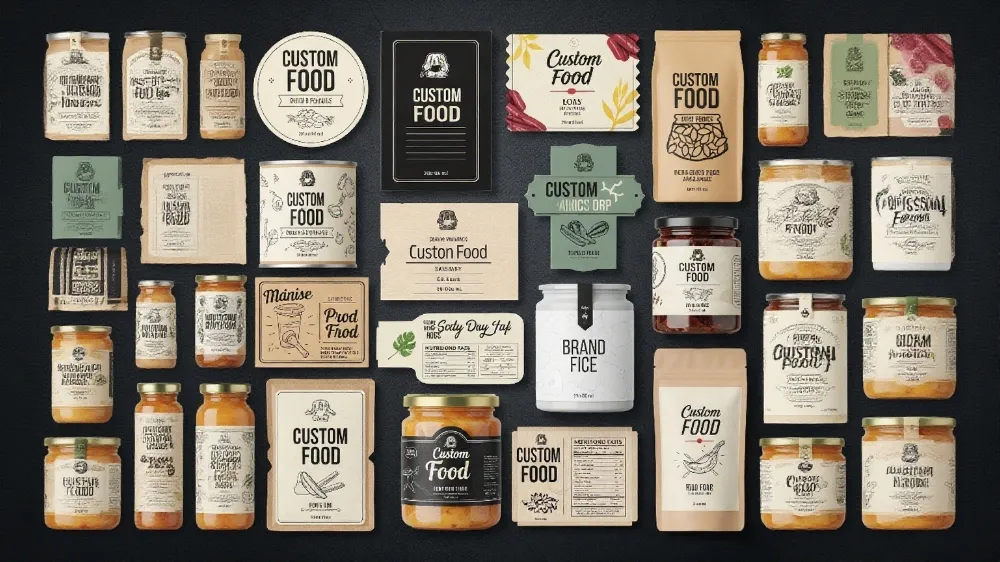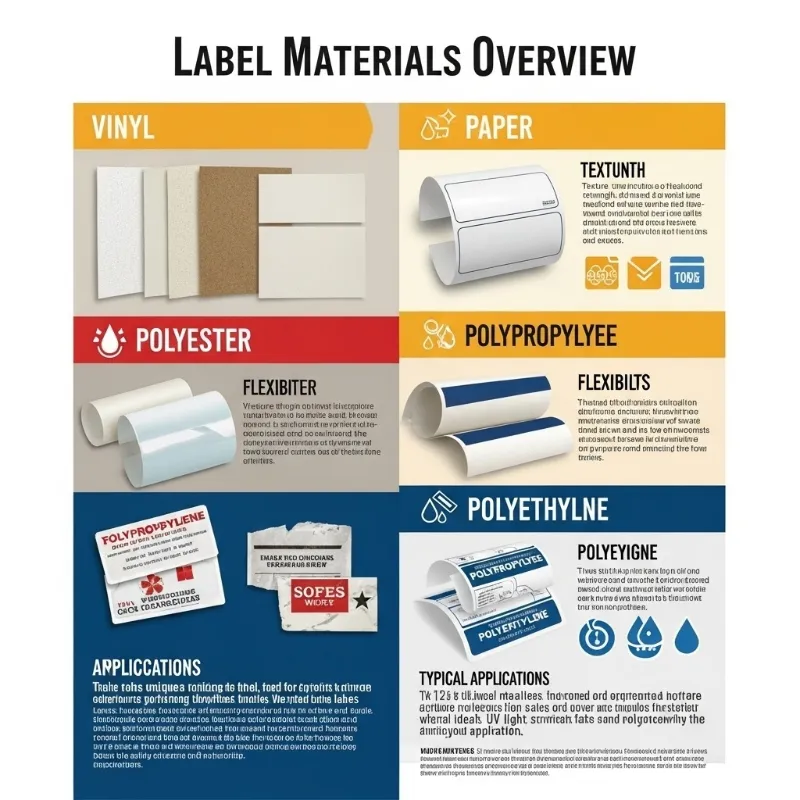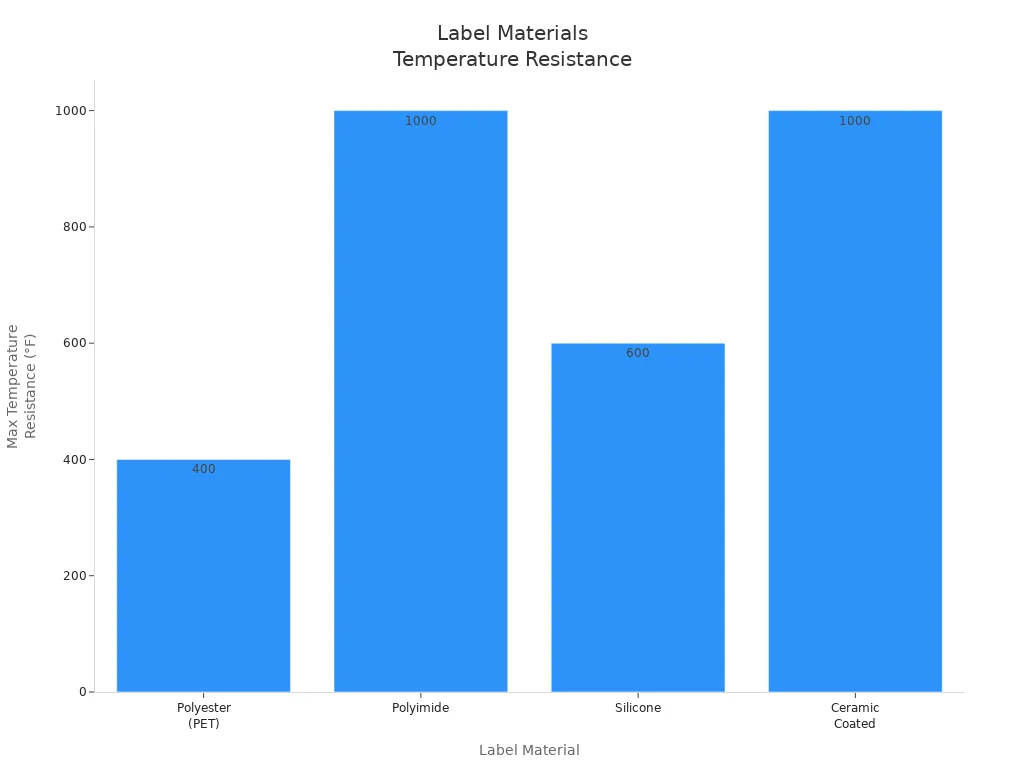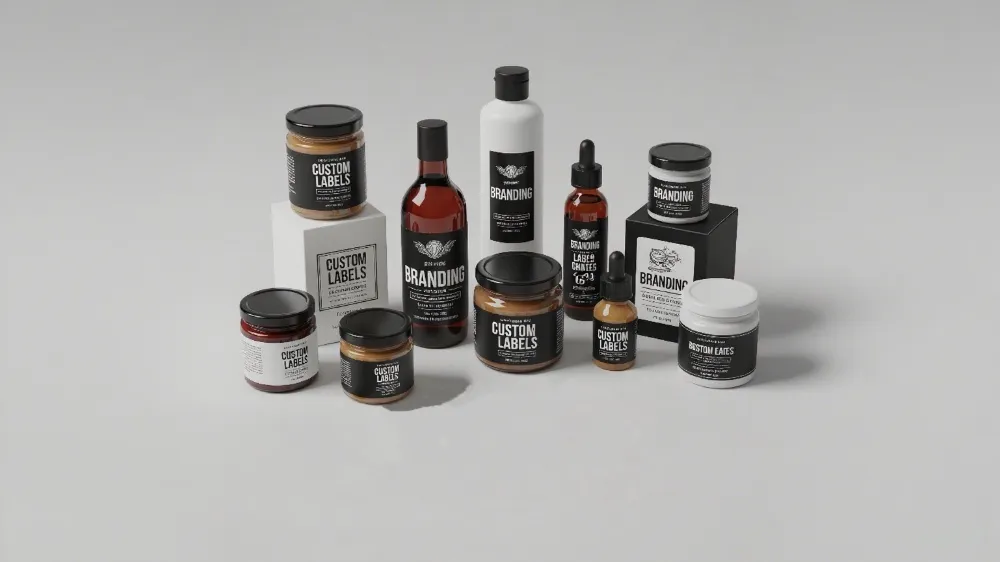
Custom adhesive label materials include vinyl, paper, polyester, polypropylene, and polyethylene. Each material has special strengths for different stickers and labels. Vinyl and polyester are strong and resist water. They work well for stickers in tough places. Paper is good for labels that need to look nice and cost less. Polypropylene is flexible and resists chemicals. It is good for special uses. Each material helps meet different design needs. These needs range from food packaging to industrial stickers. The table below shows how labels help important industries:
Industry | Common Applications and Requirements |
|---|---|
Food & Beverages | Branding, regulatory info, moisture resistance, food safety |
Personal Care | Skincare, cosmetics, oil resistance, decorative and regulatory design |
Pharmaceuticals | Tamper-evident, dosage, traceability, anti-counterfeiting |
Retail | Pricing, barcoding, branding, readability |
Industrial | Asset tracking, safety, heat and chemical resistance |
Logistics & Transport | Shipment ID, barcodes, harsh environment durability, real-time tracking |
Key Takeaways
Pick label materials by thinking about where you will use them and how. This helps the sticker stay on and last a long time. Vinyl and polyester labels are very strong. They do not get ruined by water. These labels are good for outside and rough places. Paper labels cost less money and are easy to print on. They are best for inside use and short times. Paper labels do not do well with water. Polypropylene and polyethylene labels bend without breaking. They also keep out water and oils. These labels work well for food packages and round things. Specialty films and adhesives help with heat, chemicals, or being eco-friendly. They can cost more and may need special printing.
Choosing Custom Adhesive Label Materials
When picking custom adhesive label materials, you need to think about a few things. These things decide how well the stickers work in different places. If you think carefully, your stickers will fit the product, the place, and the design.
Durability
Durability means how long stickers last and how tough they are. A strong custom adhesive label can take a lot of use and not get ruined. The material and adhesive you pick help stickers stay on and easy to read. Some label materials can handle sunlight, chemicals, and scratches. These are good for stickers that need to last a long time. How long stickers last also depends on how you store and use them. If you keep them in a cool, dry spot, they stay nice and sticky. Durable labels are needed for things that get touched a lot or go outside.
Note: Custom adhesive labels can last from a few months to over ten years. This depends on the material and where you use them.
Water Resistance
Water resistance is important for stickers in wet or damp places. Waterproof custom adhesive label materials stop ink from running and keep stickers from falling off. Some materials can handle water, humidity, and even condensation. The adhesive also needs to work well when wet to keep stickers stuck. Water-resistant and waterproof labels are needed for things in fridges, bathrooms, or outside. Picking the right material keeps stickers clear and stuck, even if they get wet.
Waterproof stickers often use polypropylene or vinyl. These materials block water and humidity.
Adhesive can change with heat or wetness, so picking the right one helps stickers last longer.
Appearance
Appearance is about how stickers look and what designs you can use. The material you choose changes how colors and prints show up. Some label materials let you pick special finishes like matte, gloss, clear, or metallic. These finishes make stickers look cool or fancy. The finish can make stickers look modern, shiny, or soft, depending on what you want. Good printing and finishing help brands stand out on shelves. The right material lets you try fun designs like embossing, foiling, or raised effects.
Design choices depend on if the material works with printing and finishing.
The finish helps stickers look good and last longer by stopping fading and scratches.
Application Surface
Where you put the sticker matters a lot when picking materials. Surfaces can be smooth, bumpy, flat, or curved. Some materials stick better to glass, metal, or plastic. Others work best on cardboard or paper. The adhesive must match the surface so stickers do not fall off. Removable stickers need special adhesives so you can peel them off without mess. For tricky surfaces like polyethylene or Teflon, you need stronger adhesives. Knowing the surface helps stop peeling, curling, or stickers falling off.
The surface’s texture and shape help you pick the right material and adhesive.
Removable and permanent adhesives are for different jobs, like short ads or long-term labels.
Tip: Always think about where and how you will use the sticker. This helps you pick the best custom adhesive label materials for good looks and strong sticking.
Label Materials Overview

Vinyl
Vinyl is a great pick for custom stickers and labels. This material is tough and can handle water, sunlight, and chemicals. Vinyl labels work inside and outside. They keep their color and do not peel off fast. Many companies use vinyl for stickers that need to last in hard places. Vinyl labels come in many shapes and sizes. You can pick matte, shiny, see-through, or metallic looks. White vinyl stickers are liked because colors look bright on them.
Vinyl labels give you:
Flexibility for flat or a little curved surfaces
Strong sticking with weatherproof glue
Clear printing for bright designs
Choices between calendered and cast vinyl, each with its own strengths
Feature | Calendered Vinyl | Cast Vinyl |
|---|---|---|
Manufacturing | Heated and rolled solid PVC sheets | Liquid PVC poured on a sheet and baked |
Thickness | Thicker and stiffer | Thinner and more bendy |
Conformability | Not good for tricky curves | Bends well for tricky shapes |
Durability | Lasts 3-7 years | Lasts 4-10 years |
Color Stability | Can fade and shrink | Does not fade or shrink easily |
Cost | Costs less | Costs more |
Ideal Applications | Flat or simple curved surfaces, indoor stickers | Car wraps, outdoor signs, bumpy walls |
Removal | Might leave sticky stuff | Easier to take off, less sticky stuff left |
Tip: White vinyl stickers and vinyl labels are best for outdoor use, bumper stickers, and product labels that face rain or sun.
Pros:
Lasts a long time and stands up to weather
Can be made in many shapes and finishes
Printing looks bright and clear
Cons:
Costs more than paper
Not as eco-friendly as some other materials
Best Uses:
Outdoor stickers, product labels, industrial stickers, promo decals, and any stickers that need to be tough.
Paper
Paper is the most used material for custom stickers and labels. It prints well and fits many designs. Paper labels cost less than film stickers. They are good for short-term or indoor use. Many brands use paper for food, drink, and store stickers. Paper comes in finishes like shiny, semi-shiny, and textured. These finishes help products get noticed.
Aspect | Advantages of Paper Labels | Disadvantages of Paper Labels |
|---|---|---|
Cost | Usually cheaper than film stickers | Some special papers cost more |
Printability | Prints well with bright colors and detailed designs | N/A |
Durability | Good for inside or short use; treated paper lasts longer | Can get wet, tear, or wear out; not good for outside |
Paper labels give you:
Cheap choices for big sticker orders
Great printing for logos and words
Lots of finishes for different looks
Note: Paper stickers lose their stick and can rip if they get wet or stay in the sun too long.
Pros:
Most paper stickers are cheap
Prints look great and colors pop
Easy to recycle and better for the planet than many plastics
Cons:
Not waterproof or oil-proof
Tears easily and does not last outside
Best Uses:
Food and drink stickers, price tags, shipping labels, store stickers, and any stickers for inside use.
Polyester
Polyester labels are strong against chemicals, water, and heat. This makes polyester a top choice for stickers in tough places. Polyester stickers can last over ten years outside. They can take heat up to 300°F for a short time. Polyester labels do not stretch much, so they are best for flat or a little curved surfaces. Many factories and electronics use polyester stickers for safety and tracking.
Label Material | Temperature Resistance | Chemical Resistance | Flexibility/Conformability | Durability/Longevity | Cost | Typical Applications |
|---|---|---|---|---|---|---|
Polyester (PET) | Up to 300-400°F | Very good | Not very bendy | Over 10 years | Medium | Electronics, engine parts, industrial stickers |
Polyester stickers give you:
Great resistance to chemicals and water
Lasts a long time in hard places
Good printing for barcodes and pictures

Pros:
Tough and waterproof
Does not fade, stands up to heat and chemicals
Good for safety and asset labels
Cons:
Costs more than polypropylene
Not very bendy for curved surfaces
Best Uses:
Industrial stickers, electronics, engine parts, safety labels, and outdoor stickers that need to last.
Polypropylene (BOPP)
Polypropylene, or BOPP, is a favorite for stickers and labels in food and drink packaging. BOPP labels do not get ruined by water, oil, or scratches. They stay clear and do not peel in cold or wet places. Polypropylene stickers come in matte, shiny, and clear looks. Many brands use BOPP for cold foods, drinks, and makeup.
Polypropylene stickers give you:
Great resistance to water and oil
Stays strong when touched a lot
Safe for food and meets FDA rules
Prints look bright and colorful
Does not tear or scratch easily
Bends for bottles and round containers
Good price for big orders
Pros:
Waterproof and oil-proof
Stays nice in fridges and wet places
Clear BOPP labels look like there is no label
Cons:
Not as bendy as polyethylene
Not as eco-friendly as paper
Best Uses:
Food and drink stickers, makeup labels, cold product stickers, and store stickers that need to be waterproof.
Polyethylene
Polyethylene labels are bendy and do not tear easily. LDPE is soft and stretches a lot. HDPE is stiffer and does not tear as much. Polyethylene stickers are good for packages that need to bend, like mailers and clothing bags. Tyvek, a kind of polyethylene, is strong, light, and hard to rip.
Property | Low-Density Polyethylene (LDPE) | High-Density Polyethylene (HDPE) |
|---|---|---|
Flexibility | Very bendy and stretchy | Stiffer and less bendy |
Tear Resistance | Okay tear resistance | Stronger and does not tear easily |
Application Relevance | Flexible packaging, mailers, clothing bags | Labels that need to be stiff and not tear |
Polyethylene stickers give you:
Good bend for round or bumpy surfaces
Light and easy to use
Okay strength for short use
Pros:
Bendy and stretchy
Light and simple to put on
Tyvek is a good eco-safe choice
Cons:
Not as tough as polyester or BOPP
Not as waterproof as vinyl or polypropylene
Best Uses:
Mailing stickers, clothing tags, flexible package stickers, and short-term outdoor stickers.
Specialty Films
Specialty films have special features for custom stickers and labels. These films include polyimide, nylon, synthetic paper, and more. Specialty films can take high heat, chemicals, or stick to special surfaces. Many jobs use these films for electronics, planes, and lab stickers.
Specialty Film / Adhesive Type | Key Properties | Best Use Cases |
|---|---|---|
Polyimide | Handles very high heat (over 300°C) | Electronics, planes, circuit boards |
Nylon | Bendy, good for fabric | Clothing tags, fabric stickers |
Synthetic Paper | Feels like paper, but tough | Tough stickers that look like paper |
Acrylic Adhesives | Handles heat, sun, and chemicals | Outside, lab, and factory stickers |
Rubber Adhesives | Sticks well, good for rough places | Hard jobs, bendy sticking |
Emulsion Adhesives | Water-based and eco-safe | Everyday and eco-safe stickers |
Solvent Adhesives | Handles chemicals, water, and heat | Special jobs, tough places |
Hot Melt Adhesives | Sticks fast and strong | Curved or odd shapes |
Custom Additives | Made for special needs | Special jobs, many uses |
Specialty films give you:
Can take high heat or chemicals
Bendy choices for fabric and round things
Eco-safe picks with water-based glue
Pros:
Works in special or tough places
Many choices for special needs
Good for eco-safe and green stickers
Cons:
Costs more for fancy films
Might need special printing or glue
Best Uses:
Electronics stickers, plane labels, lab stickers, clothing tags, and eco-safe stickers for special jobs.
Comparison Guide
Features Table
The table below shows how popular custom stickers are different. It helps people choose the best stickers for what they need.
Feature | Vinyl Stickers | Paper Stickers | Polyester Stickers | Polypropylene Stickers | Specialty Film Stickers |
|---|---|---|---|---|---|
Durability | High | Low | Very High | High | Varies |
Water Resistance | Excellent | Poor | Excellent | Excellent | Varies |
Finish Options | Matte, Gloss, Clear | Matte, Gloss, Textured | Matte, Gloss | Matte, Gloss, Clear | Matte, Gloss, Special |
Adhesive Type | Permanent/Removable | Permanent/Removable | Permanent | Permanent | Custom |
Eco-friendliness | Moderate | High (recycled options) | Moderate | Moderate | Varies |
Printer Compatibility | Digital, Screen | Inkjet, Laser | Digital, Thermal | Digital, Flexo | Special |
Best Use | Outdoor, Promo | Food, Retail | Industrial, Safety | Food, Cosmetics | Electronics, Clothing |
Note: Some stickers use recycled paper to help the planet. Others have removable glue for planners or short projects.
Pros and Cons
Every sticker type has things it does well and things it does not. The list below shows what people like and do not like about each sticker.
Vinyl Stickers
👍 Pros: Stays strong, blocks water and sun, good outside.
👎 Cons: Costs more money, not as eco-friendly as paper.
Paper Stickers
👍 Pros: Cheap, prints easily, has green choices.
👎 Cons: Rips and fades, not good in wet places.
Polyester Stickers
👍 Pros: Handles heat, chemicals, and rough use.
👎 Cons: Not bendy, costs more than other stickers.
Polypropylene Stickers
👍 Pros: Waterproof, safe for food, bends for bottles.
👎 Cons: Not as bendy as some, less green than paper.
Specialty Film Stickers
👍 Pros: Works in hard places, handles heat or chemicals.
👎 Cons: Costs more, may need special printers.
Best Applications
Picking the right sticker depends on where you use it and what it faces. Here are the best uses for each sticker type:
Vinyl stickers: Outdoor signs, bumper stickers, weatherproof labels.
Paper stickers: Food packages, price tags, store labels.
Polyester stickers: Machines, safety stickers, factory labels.
Polypropylene stickers: Food jars, drink bottles, makeup stickers.
Specialty film stickers: Electronics, lab stickers, clothing tags.
Tip: For outside, vinyl and polypropylene stickers work best. For food, paper or clear polypropylene stickers are common. Polyester stickers are good for tough jobs in factories.
Custom Label Uses

Food Packaging
Food packaging stickers must follow strict safety and quality rules. Companies pick custom labels that meet standards like SQF, BRCGS, and FSSC 22000. These certifications prove the company cares about food safety and quality. Groups like the FDA and EFSA check that labels do not let bad chemicals get into food. Labels also need to show ingredients, allergy warnings, and when food goes bad. Many brands use eco-safe roll labels to follow green rules and attract eco-friendly shoppers. Custom stickers for food packaging often use polypropylene or paper. These materials are safe, print well, and stay strong in cold or wet places.
Aspect | Details |
|---|---|
Regulatory Bodies | FDA (U.S.), EFSA (Europe), Codex Alimentarius (International) |
Materials Safety | Testing for chemical migration, risk assessment |
Labeling Requirements | Ingredient list, allergens, nutrition facts, expiration dates |
Environmental Considerations | Recyclability, eco-safe roll labels |
Traceability | Batch numbers, supplier records |
Tip: Always make sure food packaging labels meet safety and green rules.
Outdoor & Weatherproof
Outdoor stickers face rain, sun, and hot or cold weather. Vinyl, polyester, and polypropylene stickers work best for these tough jobs. These materials block water, sunlight, and chemicals. Vinyl stickers last the longest and bend with heat or cold, so they do not crack or peel. Polyester stickers stay strong and do not tear, even after years outside. Polypropylene stickers block oil and water, so they are great for wet places. Laminates and coatings add more protection and keep the design bright. Synthetic face stocks like polyester and vinyl work better than paper outside.
Outdoor stickers need strong, weatherproof materials.
UV-resistant inks and laminates help stickers last longer.
Tough roll labels keep information clear in harsh weather.
Branding & Product
Branding uses custom stickers and labels to show quality and build trust. The right material and design help products stand out and get noticed. Good labels make products look professional and show the brand is reliable. Special features like waterproof or tamper-evident stickers protect the product and the brand. Eco-safe roll labels attract shoppers who care about the planet. Custom labels with cool designs and finishes, like foil or embossing, make products look fancy. Using the same branding on all stickers and labels helps people remember the brand.
Branding uses custom stickers to make a good first impression.
Labels with special textures or finishes make products look better.
Green materials help brands with promotions and long-term success.
Well-placed stickers help shoppers find and learn about products.
Custom designs help brands connect with customers and tell their story.
Branding with strong, nice stickers helps brand promotions and trust.
Good branding materials show the brand cares about quality.
Custom labels shape how people see a product.
Temporary & Removable
Temporary and removable stickers help with short jobs like sales, inventory, or reusable containers. Removable roll labels use acrylic adhesives that let you take them off easily with no sticky mess. These adhesives let you move stickers around during use and work in different temperatures. Ultra-removable labels can be used again and again and stick well to glass, metal, plastic, and paper. Removable labels come in paper, polyester, and vinyl, depending on where you use them. These stickers do not tear or fade fast and keep printing clear. Removable roll labels are great for price tags, tracking, and any job that needs labels changed often.
Note: Removable labels with acrylic adhesives come off clean and can be used again, so they are great for changing info or short-term branding.
It is important to pick the right label material for each product. The best material depends on where you put the label, how long it should last, and how it looks. Many companies make mistakes like these:
Using labels that are not right for the product’s place, such as putting non-water-resistant labels on wet things.
Picking the wrong size or shape, which makes labels not stick well and look messy.
Not asking label experts for help with special needs.
Experts say you should check the surface, how strong the adhesive is, and what the label will face before you choose. The comparison guide and list of things to think about help you match the material to the job. Suppliers can give samples, guides, and advice to help you find the best label for your needs.
Tip: Talking to a label supplier can help you avoid mistakes and make sure your label works well.
FAQ
What is the most durable material for custom adhesive labels?
Vinyl and polyester are the toughest label materials. They do not get ruined by water, sunlight, or chemicals. These materials are great for outdoor or factory labels. They last for many years without breaking down.
Can custom labels be eco-friendly?
Yes, they can. Many companies sell labels made from recycled paper or films that break down naturally. These choices help cut down on trash. There are also special glues that are better for the planet.
Which label material works best for curved surfaces?
Polyethylene and flexible vinyl are good for curved or bumpy things. These materials bend easily and do not peel or crack. They work well on bottles, tubes, and round containers.
How can someone remove a label without leaving residue?
Removable adhesives make it simple to take off labels. These glues let you peel the label off without sticky mess. They are good for short-term uses like price tags or reusable containers.
